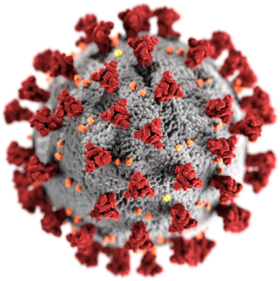Betacoronavirus
| Betacoronavirus | |
|---|---|

| |
| Các hạt MERS-CoV nhìn dưới kính hiển vi điện tử đổi màu âm bản.Các hạt virus chứa các nhú giống như chùy đặc trưng tỏa ra từ màng virus. | |

| |
| Hình minh họa virus SARS-CoV-2. | |
| Phân loại virus | |
| (kph): | Virus |
| Realm: | Riboviria |
| Ngành: | incertae sedis |
| Bộ: | Nidovirales |
| Họ: | Coronaviridae |
| Phân họ: | Orthocoronavirinae |
| Chi: | Betacoronavirus |
| Phân chi và loài[1][2] | |
| |
Betacoronavirus (β-CoV hoặc Beta-CoV) là một trong bốn chi coronavirus thuộc phân họ Orthocoronavirinae trong họ Coronaviridae của bộ Nidovirales. Chúng là các virus RNA có màng bọc, chiều dương, đơn chuỗi với nguồn gốc từ động vật. Mỗi chi coronavirus bao gồm các dòng dõi virus khác nhau, với chi Betacoronavirus chứa 4 dòng dõi như vậy. Trong các tài liệu cũ, chi này còn được gọi là coronavirus nhóm 2.
Các Beta-CoV có tầm quan trọng lâm sàng lớn nhất liên quan đến con người là OC43 và HKU1 của dòng dõi A, SARS-CoV và SARS-CoV-2 của dòng dõi B,[3] và MERS-CoV của dòng dõi C. MERS-CoV là betacoronavirus đầu tiên thuộc dòng dõi C được biết là lây nhiễm sang người.[4][5]
Các chi Alphacoronavirus và Betacoronavirus xuất phát từ kho gen của loài dơi.[6][7][8]
Tham khảo[sửa | sửa mã nguồn]
- ^ “Virus Taxonomy: 2018 Release”. International Committee on Taxonomy of Viruses (ICTV) (bằng tiếng Anh). tháng 10 năm 2018. Truy cập ngày 13 tháng 1 năm 2019.
- ^ Woo, Patrick C. Y.; Huang, Yi; Lau, Susanna K. P.; Yuen, Kwok-Yung (ngày 24 tháng 8 năm 2010). “Coronavirus Genomics and Bioinformatics Analysis”. Viruses. 2 (8): 1804–1820. doi:10.3390/v2081803. ISSN 1999-4915. PMC 3185738. PMID 21994708.
Figure 2. Phylogenetic analysis of RNA-dependent RNA polymerases (Pol) of coronaviruses with complete genome sequences available. The tree was constructed by the neighbor-joining method and rooted using Breda virus polyprotein.
- ^ “Phylogeny of SARS-like betacoronaviruses”. nextstrain. Truy cập ngày 18 tháng 1 năm 2020.
- ^ ProMED. MERS-CoV–Eastern Mediterranean (06) (http://www.promedmail.org/)
- ^ Memish, Z. A.; Zumla, A. I.; Al-Hakeem, R. F.; Al-Rabeeah, A. A.; Stephens, G. M. (2013). “Family Cluster of Middle East Respiratory Syndrome Coronavirus Infections”. New England Journal of Medicine. 368 (26): 2487–2494. doi:10.1056/NEJMoa1303729. PMID 23718156.
- ^ Woo, P. C.; Wang, M.; Lau, S. K.; Xu, H.; Poon, R. W.; Guo, R.; Wong, B. H.; Gao, K.; Tsoi, H. W. (2007). “Comparative analysis of twelve genomes of three novel group 2c and group 2d coronaviruses reveals unique group and subgroup features”. Journal of Virology. 81 (4): 1574–1585. doi:10.1128/JVI.02182-06. PMC 1797546. PMID 17121802.
- ^ Lau, S. K.; Woo, P. C.; Yip, C. C.; Fan, R. Y.; Huang, Y.; Wang, M.; Guo, R.; Lam, C. S.; Tsang, A. K. (2012). “Isolation and characterization of a novel Betacoronavirus subgroup A coronavirus, rabbit coronavirus HKU14, from domestic rabbits”. Journal of Virology. 86 (10): 5481–5496. doi:10.1128/JVI.06927-11. PMC 3347282. PMID 22398294.
- ^ Lau, S. K.; Poon, R. W.; Wong, B. H.; Wang, M.; Huang, Y.; Xu, H.; Guo, R.; Li, K. S.; Gao, K. (2010). “Coexistence of different genotypes in the same bat and serological characterization of Rousettus bat coronavirus HKU9 belonging to a novel Betacoronavirus subgroup”. Journal of Virology. 84 (21): 11385–11394. doi:10.1128/JVI.01121-10. PMC 2953156. PMID 20702646.
